A GUIDE TO SOME OF AUCKLAND’S
Less Crappy BOAT RAMPS
By Mark Kitteridge

Judging by our boat ramps, it really does seem as if boat fishers are deliberately and systematically being eradicated from Auckland waters.
I launch from ramps all over the area’s east coast, from Omaha in the north to Kawakawa in the south. Most are selected because they offer the best launching and retrieving experiences for that part of the country, yet virtually all still involve significant challenges, drawbacks and problems that spoil the overall experience.
By far the worst problem is a lack of dedicated parking, even in heavily populated areas, with few ramps offering more than 10-30 parks, and when they do, many will be taken up illegally by beachgoer and café-patron cars and/or camper vans, or it costs a fortune to park there for the day.
Otherwise it can be poor ramp design or a lack of maintenance, and if it’s not these issues, you might be asked to pay through the nose for ‘launching and retrieving rights’ by marinas or to buy a club membership to gain club ramp use (the last I do understand, but I never use any one location to warrant the initial annual club payment, even though these usually reduce significantly in price afterwards). Or maybe there will be no longterm parking spaces for fishing mates bringing their own cars, or perhaps problems with silt, tidal limitations, no protections from swells, issues with thieves… the list goes on.
So here are a few of the ‘better’ ramps out of a rather motley assortment, starting with lovely Omaha and heading southwards.
Omaha Boat Ramp (1)
Boat sizes catered for: All sizes.
Ramp type: Concrete, three lanes.
Tidal restrictions: None.
Approximate trailer parking capabilities: Heaps (I’m guessing 60-80 onsite), with overflow parking available further up the road.
Payments involved: None.
Ramp advantages: Good launching pad for trips to Little or Great Barrier Islands, as well as the Mokohinau Islands; onsite toilet; plenty of parking; protected from swells; and a nearby pontoon jetty allows the loading and unloading of passengers.
Disadvantages: There can be very long queues on calm days, even early in the morning, leading to lengthy waits. Also, the ramp’s gradual slope sees cars having to reverse into deeper water than ideal; the locals tend to veer off one side of the ramp onto the sand to launch/retrieve in deeper water and this can create sinkholes from power loading/ unloading that can be hazardous.
Sandspit Yacht Club/Marina Ramp (2)
Boat sizes catered for: All sizes. Ramp type: Single concrete. Tidal restrictions: None. Approximate trailer parking capabilities: Very limited and only available onsite to club members (unless by arrangement); the public must park further up the road at least 100 metres away. Payments involved (at the time of writing): $15 to launch and $15 to retrieve, plus ‘processing’ charges!
Ramp advantages: The adjacent pontoon jetty allows a dry launch, temporary berthing and the loading of passengers.
Disadvantages: Bloody expensive; no onsite parking for the public (unless by special arrangement); and the single lane makes for queues on busy days.
Sandspit Beach Ramp (3)
Boat sizes catered for: All sizes, but somewhat tidal dependent, especially near the top of the tide for bigger vessels.
Ramp type: Starts as a short twinlane concrete ramp around high tide, then becomes a firm, fastsloping sand beach during the lower-tide phase.
Tidal restrictions: Yes, as already mentioned, but the fast-changing tidal depth often makes things possible within 15-30 minutes.
Approximate trailer parking capabilities: The nearby car park has a dedicated boat trailer area, but lack of supervision is currently allowing boats, trailers, vans and trucks to be stored there long term, chewing up valuable trailer parking spaces so none are left on popular days.
Payments involved: None currently, but I hear that’s possibly because things are about to change in a big way, and not for the better as far as boaties are concerned!
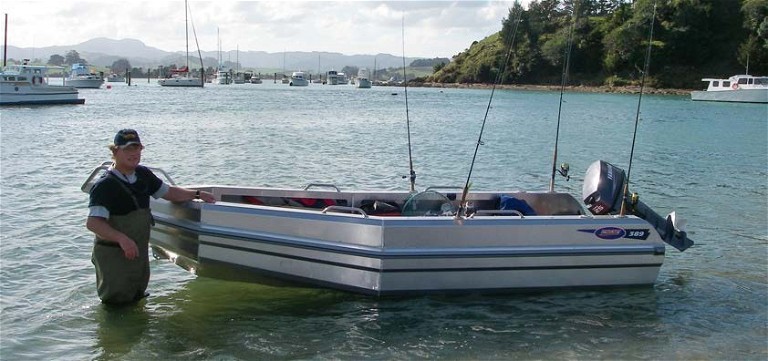
Launching from Sandspit Beach means getting wet and having to clean your car afterward.
Ramp advantages: Free launching, and nearby parking and toilets.
Disadvantages: At least one person will get wet while launching and retrieving, and as there’s nowhere for single-handed boats to be tethered, most fishers drop the anchor and make a dash to the car park and back. Also, as most of the launching tends to be done from the potholed sandy beach 100 metres away, vehicles need to get thoroughly cleaned afterwards, inside and out.
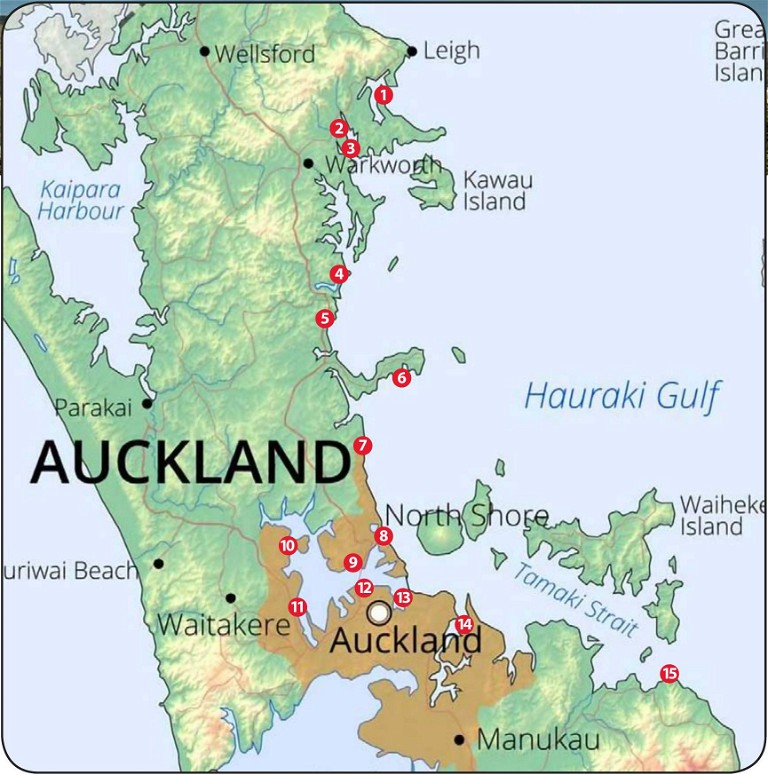
Wenderholm Regional Reserve Ramp (4)
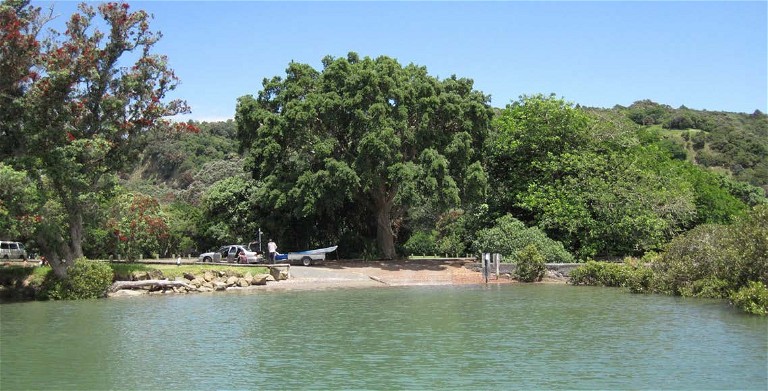
High tide at Wenderholm Regional Park is a welcome sight, but lower tidal phases can result in a messy experience!
Boat sizes catered for: Small to medium vessels only.
Ramp type: Single concrete lane.
Tidal restrictions: Extremely tidal; work around 2.5 hours either side of low tide.
Approximate trailer parking capabilities: Modest trailer parking available.
Payments involved: None.
Ramp advantages: Free to use, toilets available, sheltered from the wind and swell, and provides a great springboard to the Mahurangi.
Disadvantages: There is very limited boat launching and retrieving access for several reasons:
The reserve’s gates are open and shut to the public each day, depending on the time of year (but will automatically open to vehicles going back out).
The huge tide variance sees the Puhoi River almost dry up, and even when it’s pretty full, it needs to be navigated with care.
Muddy silt has settled on the ramp’s lower section recently, reducing the depth still further and making the process a very messy affair at times!
Hatfields Beach (5)
Boat sizes catered for: Small to medium (safely).
Ramp type: Single concrete ramp during higher tide phases, with many users preferring to launch from the usually firm sand beach at other times, as the slope can be better than that of the ramp in places, avoiding the need to get vehicles too deep in seawater. Tidal restrictions: Mostly possible throughout for smaller vessels, although some may require the trailer to be detached, the jockey wheel deployed, then pulled out with a length of rope.
Approximate trailer parking capabilities: Very limited, so get in quick.
Payments involved: None.
Ramp advantages: Free to launch, toilets nearby, and plenty of good fishing options not too far away.
Disadvantages: The shallow ramp slope can see cars having to back into salt water deeper than they’d like, and occasionally the sand can be a bit unstable in places, so launching with a 4WD is recommended. Also, swells from the east/southeast make boat launching or retrieving a very unpleasant/costly experience.
Gulf Harbour Marina Ramp (6)
Boat sizes catered for: All sizes.
Concrete or beach: Concrete twin-lane with single pontoon finger.
Tidal restrictions: None.
Approximate trailer parking capabilities: Good amounts of trailer parking, and the large grassy areas can also be utilised if necessary on busy days.
Payments involved: None.
Ramp advantages: Dry launching (especially appreciated during the winter) and not too much swell, thanks to the breakwater created; the finger pontoon provides temporary berthing and the loading of passengers and gear; and toilets are available.
Disadvantages: This ramp can be very popular but having just the two ramp lanes (one with launching priority and the other with retrieving priority) frequently results in decent queues, resulting in lengthy waits. This is especially problematic around low tide, when only the end of the pontoon remains in deep enough water, enabling just one boat to be berthed each side. Also, the nearby designated trailer spots are often gobbled up by single cars or camper vans during the summer, leading to longer walks for those in charge of parking.
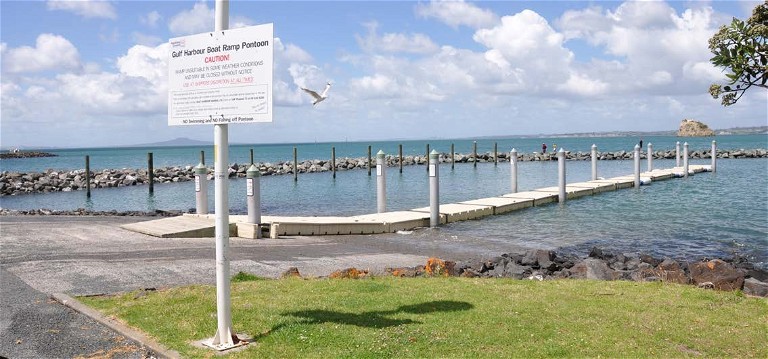
Gulf Harbour Marina ramp.
Waiake Beach Reserve (7)
Boat sizes catered for: Small to medium vessels
Concrete or beach: Concrete leading down to a firm sand beach (Little Waiake).
Tidal restrictions: One hour either side of low tide sees the area become pretty flat and shallow (a rope/strop tied to the trailer can avoid the need to put your car into the tide). However, 4x4s unafraid of getting wet can still launch or retrieve modestsized craft. At high tide the small beach allows little room for turning, so it’s best to reverse down the ramp.
Approximate trailer parking capabilities: Very limited; generally lining the access road.
Payments involved: None.
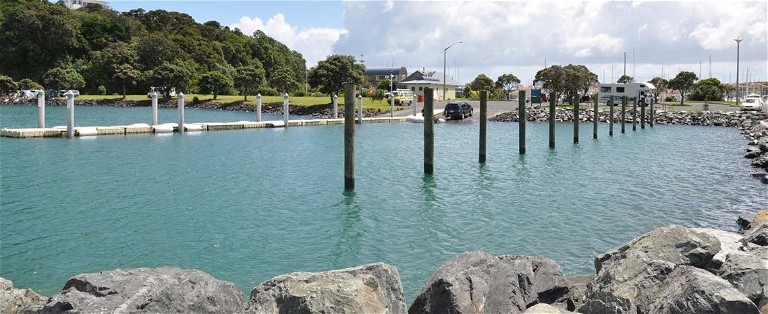
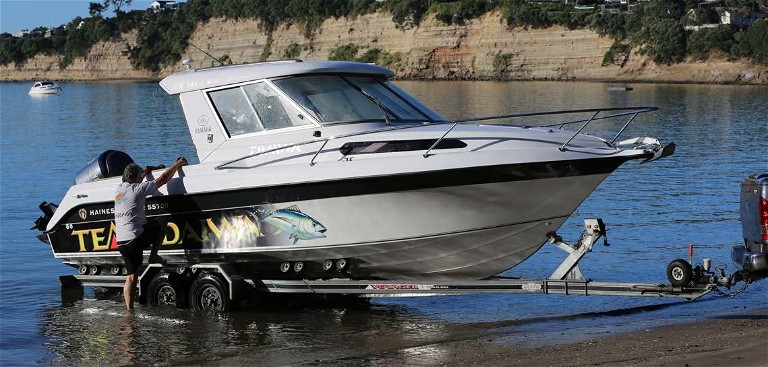
Waiake can provide a very pleasant launch-and-retrieve experience, but parking is very limited and the ramp can be tricky when wet!
Ramp advantages: Wellprotected and usually without much swell, except when winds are from the southeast.
Disadvantages: The limited parking can see trailers parked hundreds of metres away, and there’s nowhere for vessels to tie off, making life difficult for solo fishers. Swells from the southeast can make for hairy launches and retrieves. Plus, the concrete ramp gets slippery from previous cars and trailers, so it pays to get a bit of a run-up beforehand!
Takapuna Boat Ramp (8)
Boat sizes catered for: All sizes.
Concrete or beach: Concrete three-lane.
Tidal restrictions: None.
Approximate trailer parking capabilities: 40-50.
Payments involved: None if you’re lucky enough to get a trailer park onsite. Friends joining you in their own cars will need to park hundreds of metres away in the parking building and pay for the privilege.
Ramp advantages: Reasonably sheltered, except towards high tide with nor’east swells pushing in, and handy to local fishing around Rangitoto, Motutapu and the Noises. There are a couple of tie-off positions for solo boaties, and the small breakwall provides a slim access point for passengers to get on and off.
Disadvantages: The bloody parking! This ramp should potentially be catering for thousands of boaties living north of the bridge, yet the allocated parking is pathetic! Also, the cartrailer spaces are so cramped it’s virtually impossible to get them in and out without hitting nearby rigs. To make matters worse, ignorant beachgoers and café patrons frequently plonk their cars into the valuable trailer spots. When the ramp’s trailer parking is full, you’re in trouble. Nearby car parks require payment and only allow up to two hours’ parking – useless when you’re out on the water for a decent session. This sees cars and trailers parked many hundreds of metres away at times, leading to long walks back and forth, which also holds up the launching and retrieval processes at this busy ramp.
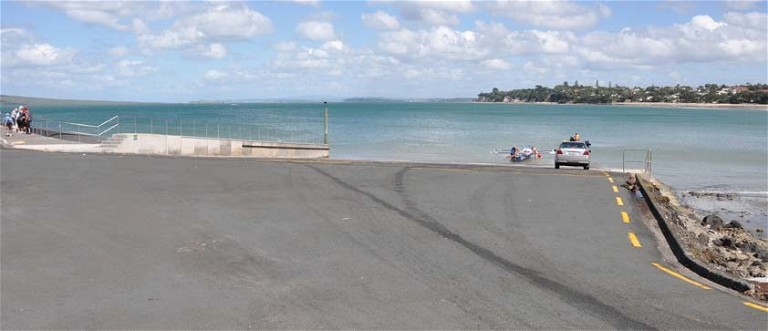
Takapuna Ramp ticks quite a few boxes, but the minimal dedicated parking means very few North Shore anglers can actually use it.
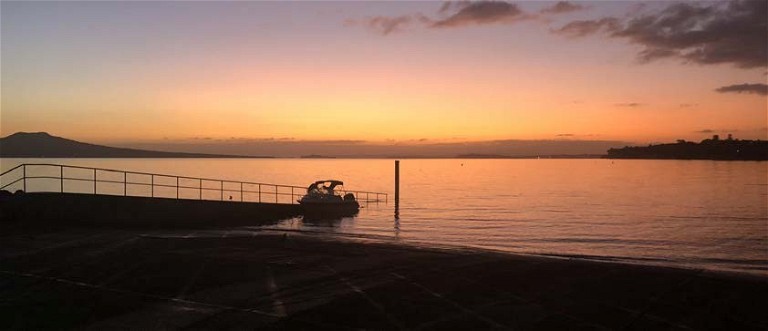
Birkenhead Boat Ramp (9)
Boat sizes catered for: All sizes.
Concrete or beach: Two-lane concrete, with no pontoon.
Tidal restrictions: All tide.
Approximate trailer parking capabilities: Limited.
Payments involved: None.
Ramp advantages: Good slope and generally protected.
Disadvantages: Exposed to south/southeast conditions and ferry wake.
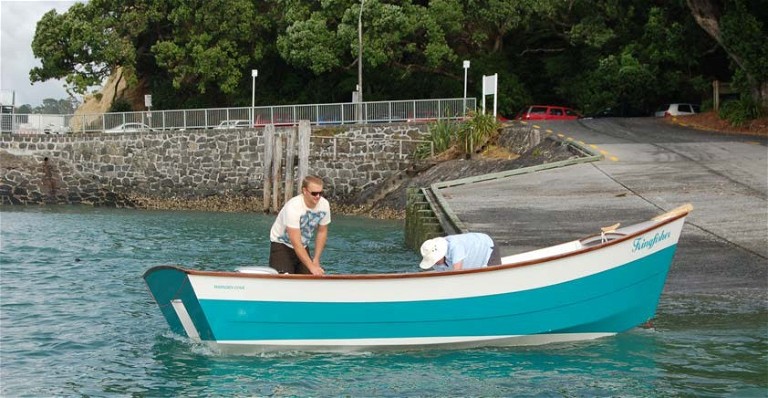
Birkenhead boat ramp.
Hobsonville Marina Ramp (10)
Boat sizes catered for: All sizes.
Concrete or beach: Two-lane concrete, with a pontoon finger.
Tidal restrictions: All tide.
Approximate trailer parking capabilities: Limited parking available for cars and trailers next to the ramp.
Payments involved: Small daily fee of $5 is charged for a car and trailer to park for the day.
Ramp advantages: All weather; all tide; as the ramp is located alongside the Hobsonville Marina, there are good facilities with a nearby dairy, chandlery and toilets.
Disadvantages: Located far up the Waitemata Harbour.
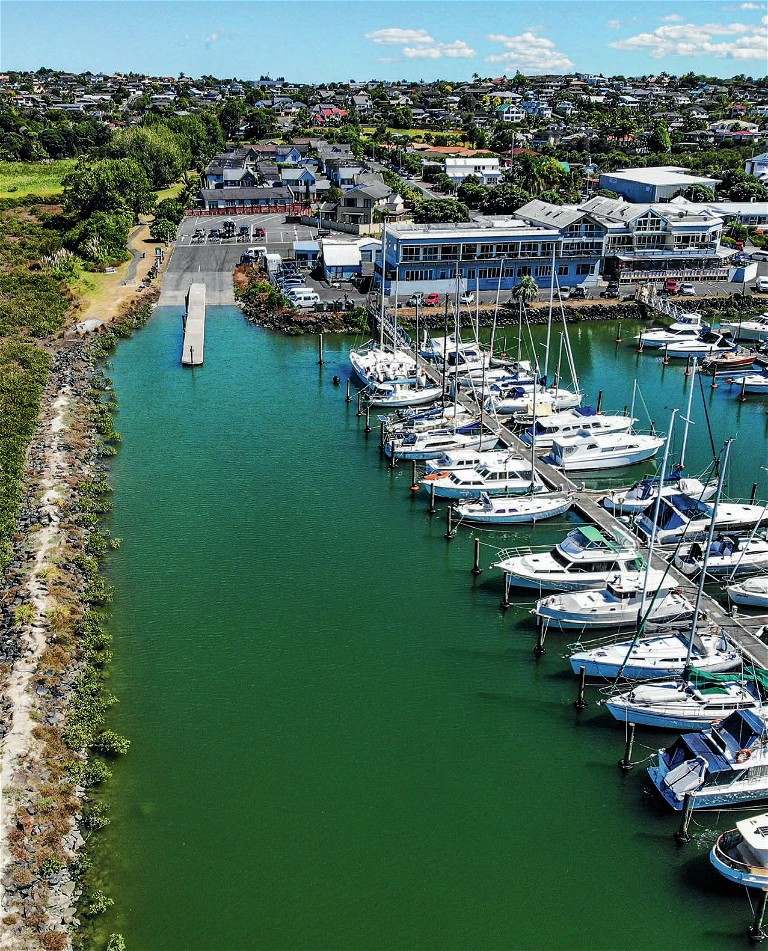
Hobsonville Marina ramp.
Te Atatu Boating Club Ramp (11)
Boat sizes catered for: All sizes.
Concrete or beach: Multi-lane concrete, with a pontoon finger.
Tidal restrictions: All tide.
Approximate trailer parking capabilities: Extensive.
Payments involved: $20 fee for non-members; free for members.
Ramp advantages: All weather; all tide; great facilities.
Disadvantages: On the western side of the harbour launching into Whau River, so some distance to travel to get into the Gulf proper.
Westhaven Marina Public Boat Ramp (12)
Boat sizes catered for: All sizes.
Concrete or beach: Multi-lane concrete, with two pontoon fingers.
Tidal restrictions: All tide.
Approximate trailer parking capabilities: Up to 60.
Payments involved: $4-5 per barrier arm movement, plus parking charges. The latter are reasonable for a few hours, but then skyrocket to become a full day and a ridiculous amount payable, with no inbetween options possible!
Ramp advantages: A fantastic ramp that can be used in all conditions; great for solo anglers to tie off on; easy to load and unload passengers; a reasonable amount of parking (due to some projects around the marina, the number of trailer spaces has been temporarily reduced); nearby toilets; and food and drink available.
Disadvantages: Overly bloody expensive!
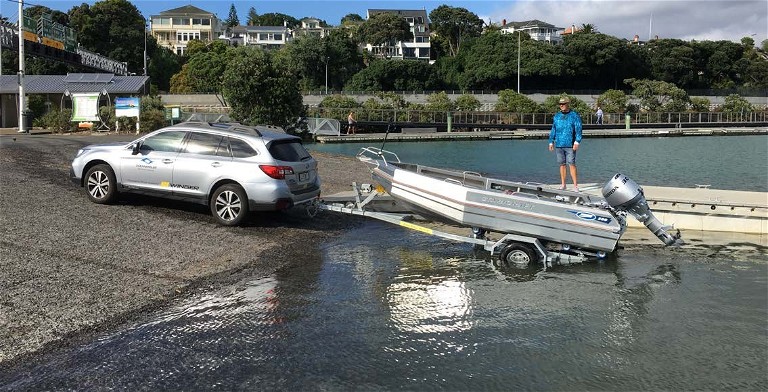
Westhaven’s multi-lane ramp is a beauty, making the charges for ramp use acceptable, but the full-day parking charges there are horrific.
Okahu Bay Public Ramp (13)
Boat sizes catered for: All sizes.
Concrete or beach: Concrete, multi-lane with two pontoon fingers.
Tidal restrictions: All tide access.
Approximate trailer parking capabilities: Pretty good – one of the best.
Payments involved: Sporadic parking fees payable.
Ramp advantages: Sheltered from most swells; ‘potentially’ good for short-term berthing and the loading and unloading of passengers; clean, modern toilets available onsite; and the ramp slope makes for easy launching, BUT…
Disadvantages: Poor/nonexistent maintenance can see this ramp become dangerously slippery for people and cars alike, although at the time of writing it wasn’t too bad.
So all in all a pretty good effort - a rare thing!
Half Moon Bay Boat Ramp (14)
Boat sizes catered for: All sizes.
Concrete or beach: Concrete, four-lane with pontoon fingers.
Tidal restrictions: All tide access.
Approximate trailer parking capabilities: Lots of parking spaces.
Payments involved: None.
Ramp advantages: Sheltered from all weather conditions; lots of parking; clean, modern toilets available onsite; and the ramp slope makes for easy launching on all tides.
Disadvantages: The parking spaces fill up quickly on busy days; Sealink car ferries on the adjacent ramp and other marina traffic means the water can often be busy.
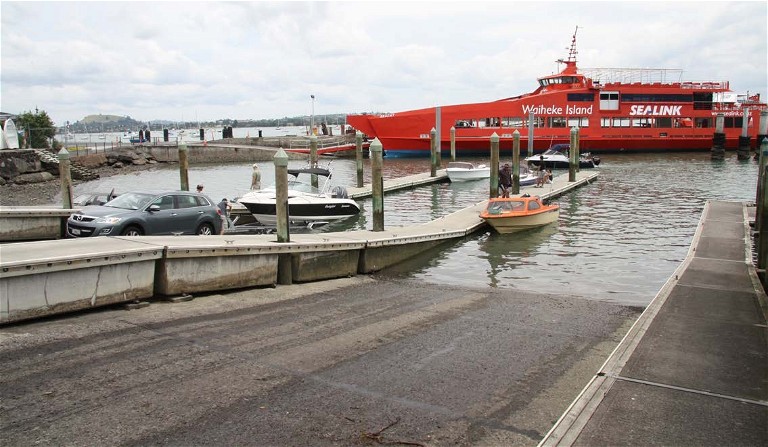
Half Moon Bay boat ramp.
Kawakawa Bay Boat Club Ramp (15)
Boat sizes catered for: All sizes.
Ramp type: Concrete, multilane with three floating pontoon fingers.
Tidal restrictions: None.
Approximate trailer parking capabilities: Decent allocated trailer parking, mostly in an area above the ramp access road.
Payments involved: If you’re a visitor, it’s a very reasonable $20 a day for access to the club’s private ramp. Or you can join for $200 (current season) with an ongoing annual fee of $120.
Ramp advantages: Much better than the public boat ramp found approximately 200 metres to the south on Kawakawa Bay Coast Road, which is only usable at the high part of each tide and less suitable for larger boats; sheltered from any swells and located nicely to some great fishing locations; easy launching and berthing; easy loading and unloading of passengers; overseen by helpful staff; brand new pontoons put in late last year.
Disadvantages: Oh. Not any, really… other than it’s too far away for me to regularly use!
So happy fishing everyone; get out and enjoy yourself while you still can!